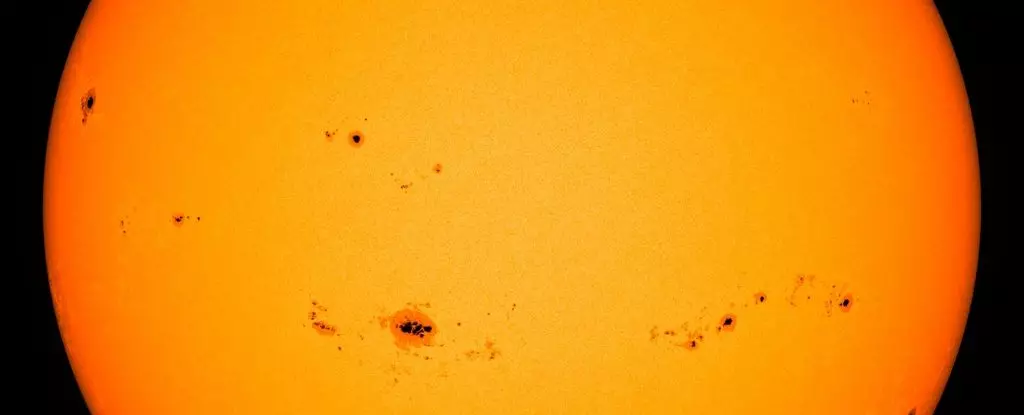

The recent announcement from NASA, the National Oceanic and Atmospheric Administration (NOAA), and the Solar Cycle Prediction Panel signifies an exciting phase in solar physics—the commencement of solar maximum. This phase indicates that our Sun, which exhibits an 11-year cycle of solar activity, has reached a peak, paving the way for a surge in sunspots, solar flares, and coronal mass ejections (CMEs). Such phenomena not only highlight the dynamic nature of solar behavior but also raise important questions regarding their impact on terrestrial technology and human activities.
As solar maximum unfolds, it is crucial to understand that this does not merely imply the Sun’s activity is at its zenith but also sets the stage for the potential oscillation between periods of intense solar output and quieter phases known as solar minimum. The specific timing of the peak of this activity, however, will remain uncertain, complicating predictive models greatly and leaving scientists, meteorologists, and the public alike at the mercy of solar whims.
At the heart of solar activity is the mysterious force of the solar dynamo, responsible for generating magnetic fields that manifest as sunspots—a feature prominent in the Sun’s surface during solar maximum. Scientists have yet to fully decipher the processes driving these cycles, which are not only pivotal for understanding solar phenomena but also essential for safeguarding technology susceptible to solar effects.
Mike Wheatland, a solar astrophysicist at the University of Sydney, emphasizes the unpredictability of these solar cycles: while they average around 11 years, each cycle’s intensity and duration can significantly vary, stretching our predictive capabilities. This uncertainty poses challenges for those relying on predictions to mitigate the technological risks associated with solar outbursts.
Sunspots denote regions where the magnetic field is notably concentrated, leading to cooler, darker patches on the Sun’s surface. During solar maximum, these spots become alarmingly more numerous, turning the solar disk into a dappled canvas. The process governing how these spots develop and dissipate can release immense energy when the tangled magnetic lines of force break loose, resulting in flares that can disrupt radio communication on Earth.
CMEs, in a more dramatic interplay, represent discharges comprised of charged particles that can travel through space and hit Earth, causing geomagnetic storms that can affect power grids and navigation systems. Although such events raise the stakes for potential disruptions, they can also yield breathtaking auroras, resulting from interactions between solar particles and Earth’s atmosphere, which many celebrate as a natural wonder.
Despite the surge in solar activity, current assessments indicate that while this solar cycle has surpassed initial predictions in intensity, it remains benign concerning historical extremes. Notably, an X9.0 flare recorded on October 4 stands as a significant event, yet is just a fraction of more powerful flares encountered in decades past.
Rising activity provides opportunities to advance our understanding of solar phenomena. The discrepancies between early predictions and observed activity call for detailed analysis and potential revisions of current solar models. Such insights could ultimately refine our approach to forecasting future solar cycles and mitigating their impact on technology—a venture that could be critical as global reliance on such technologies continues to expand.
With the arrival of solar maximum, researchers and scientists stand at the precipice of new discoveries within solar physics. The coming years will likely reveal answers to long-standing questions, not only about the unpredictability of solar cycles but also about the intricate dynamics governing solar activity.
As participants in this cosmic dance, we should remain alert and prepared, knowing that while the Sun is an essential entity for life on Earth, it is also a formidable force subject to unpredictable behavior. Our understanding of its activity cycle is poised for significant evolution, highlighting the need for continued monitoring and research. The excitement surrounding solar maximum is not merely about the power of the Sun; it is also a reminder of our place in the universe and the perpetual quest for knowledge about these celestial phenomena.
Natural gas leaks are a growing concern in both urban and rural settings, with potential…
Recent groundbreaking research at the University of Vienna has unveiled a novel interplay of forces…
In recent years, perovskites have garnered significant attention in the fields of materials science and…
For decades, astronomers have probed the depths of the Milky Way, grappling with two perplexing…
Foreign direct investment (FDI) in developing nations has long been heralded as a path to…
As spring beckons in April and May, stargazers have the unique opportunity to witness nature's…
This website uses cookies.